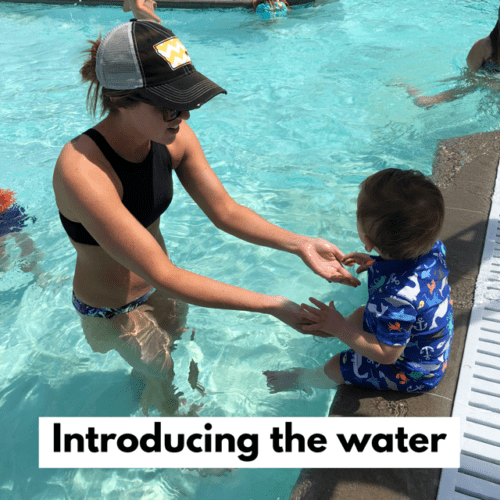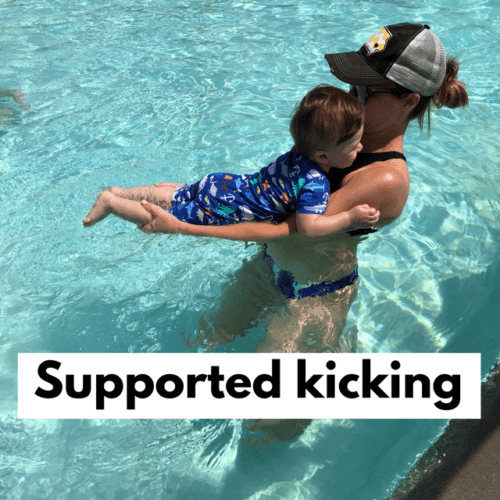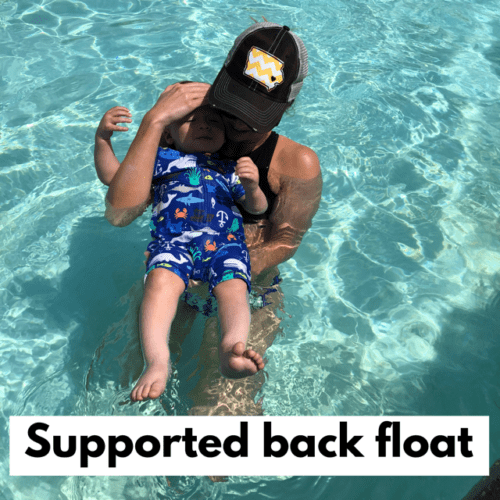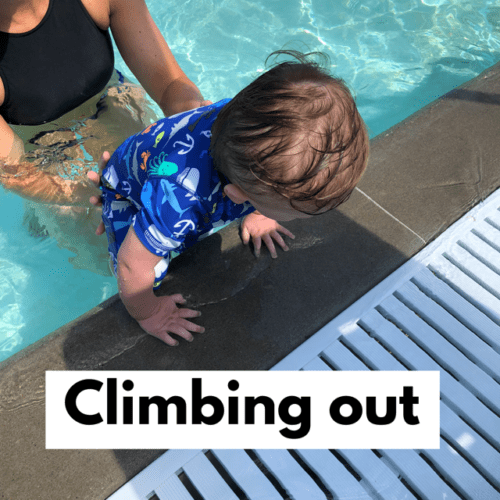Toddlers…too young for group swim lessons (bless their hearts), but old enough to be curious about the water. That tricky combination could make any parent feel as though they’re in aquatic limbo. Luckily there are easy moves you can teach on your own–pool not included! As a ‘retired’ private swim instructor, I would like to share the foundational water skills my 13-month-old has been practicing this summer, including some tips and tricks I’ve picked up over nine summers of teaching!
*Note: I will not include much about full submergence underwater. It is not my personal philosophy to rush any parent into dunking their child.*
Before we really ‘dive’ in, a few things to remember before beginning:
Before Beginning
- Sun protection is essential! Apply sunscreen on you and babe at least twenty minutes before getting wet.
- Swim diapers. Because nobody wants to be responsible for a ‘murky water’ pool closing!
- I like to take my son to the pool for short amounts of time, only planning to be in the water 15-20 minutes. That way it’s still
tolerableenjoyable for us both after we’re done.

Introducing the Water
Sit next to your child at the edge of the pool. Stretch one arm across your child’s chest as you slide into the water facing them. Your arm will act as a safety precaution, and this method is modeling to your child how to safely slide into the water. Once in, gently splash your child’s feet and help them do some kicking.
A fun way to bring them into the water is by playing a little ‘red light, green light kickers.’ Hold their feet and do fast kicks with them for green light, and freeze on red. Make this silly! By the time you’re done playing this quick warm-up, they’ll be excited about playing in the pool!
Another gentle approach is using a nursery rhyme to coax your tot. ‘Humpty Dumpty’ lends some relevancy, as well as ‘I’m a Little Teapot.’ The key here is to hold their hands, guide them in while singing, hold them close, and remain confident. If you act like this was no big deal, they’ll mirror that calmness.

Supported Kicking
Remember that ‘red light, green light kickers’ game you already introduced to them? Now that your little one is in the water, build on that experience by kicking around the shallow end of the pool! Make sure your child is holding onto your neck or shoulders, and as horizontal as they’ll allow. Just below the knees, help them flutter kick in small, quick motions.
Engage in some races with your spouse or a friend, with your child kicking and you moving backwards. (Look out for other swimmers!)
If your toddler is more advanced, have them grip the edge of the pool while you guide their kicks.

Fun with Bubbles
I don’t know about you, but my toddler LOVES to blow raspberries incessantly often. Leverage that messy habit by teaching them to blow raspberries on the surface of the water! Model what you’d like them to do, see if they’ll blow raspberries well above the water, then try it on the water.
If your child is having none of that, see if they can practice blowing out the birthday candle (your index finger). Gradually lower your finger until it’s underwater.
Admittedly, my son has yet to blow bubbles under the water, but we’ll keep practicing!

Supported Back Float
Keep calm and float on. Ah, if only it was that easy!
Teaching your child to back float could potentially save his or her life one day; it’s one of the most critical moves in learning to be safe in the water. The back float (and being able to turn onto their back to float) is essential because the swimmer can still breathe and stay above water for long periods of time. Teach your child early to turn onto their back whenever they get fatigued in the water and aren’t sure they can swim to the wall or shallow end. Big kids should practice to turn onto their backs, take a few calming breaths, and get to a safe place. But okay, off my soapbox and back to toddlers…
Toddlers just need to become accustomed to the feeling of floating. Trust me, many of them will initially hate this one. Make it as relaxing and comfortable as possible. Gently place your child’s head into the nook of your shoulder and neck, leaning your head against the side of his face. Use one hand to support their back, and the other to block the glare of the sun.
Sway side to side, quietly singing ‘Twinkle Little Star,’ or the alphabet. For older toddlers, count backwards from 10. In my experience, offering a three-year-old the opportunity to wear my ‘movie star sunglasses’ can buy me 10-20 seconds of back floating acceptance. If you haven’t been already, lay on the love and positive reinforcement after this one!

Climbing Out
Throughout your time in the water, practice climbing out (about five times). Your toddler may be too young to understand this, but they need to be able to get themselves out of the pool one day if they can’t get to the stairs. Think, ‘elbow, elbow, knee, knee.’ Their elbows reach out to the deck, then their knees do the rest.
Practice ‘catching the wall’ each time you climb out. Hold your child so he or she is facing the wall. Use, ‘on your mark, get set, catch the wall!’ to push them towards the edge with their arms reaching out. Once they’re holding on (with your desired level of support), help them climb out by pushing their knees up from below.
There you have it! I hope a takeaway from this post is that learning to swim is accessible to young children. It can also be a really fun bonding experience for you and your little one! Oh, and did I mention the best part of mommy and toddler swim time? The EPIC nap that will take place afterwards. Trust me on this one, you’ll they’ll be wiped!











Great tips! I’m going to use these the next time we go swimming!
Thanks for sharing the best information.